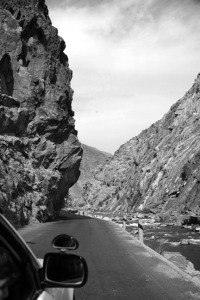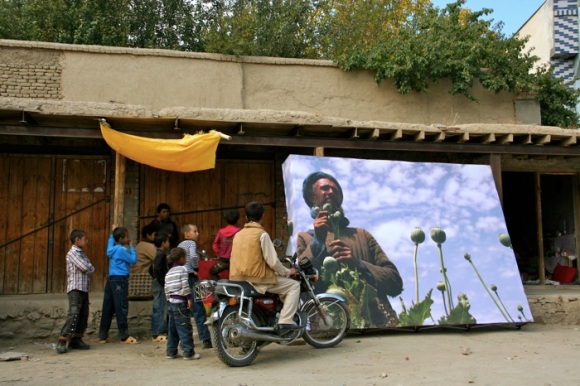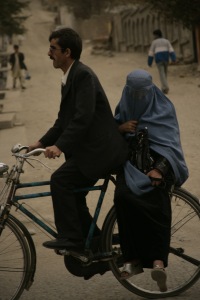
Today, we spent the day in Panjshir province – yes, I know I said I wasn’t going to leave Kabul, but you all know me too well to realize that that was never going to happen.
Security situation on the road was checked the last night and again this morning and it was determined, that yes, we could make the drive. I was keen to make the trip after our meetings yesterday at AINA Photo Agency. The reason being that we were invited by Faheem Dashty, the founder of Kabul Weekly. Faheem was with Afghanistan’s beloved resistance leader, Massoud, when he was assassinated just days before 9/11. He himself was gravely injured but he survived and resurrected the Kabul Weekly as Afghanistan’s largest independent newspaper. He has a keen political mind and is passionate about the future of Afghanistan. He and I spoke at length after the meeting at AINA, and warmly invited us to come to visit his family’s home. An offer I couldn’t refuse.
We set off at 8am, myself, Tony, Najibullah, Najibullah’s small son Serat, and of course, our faithful and daring driver, Shah Mohammed. One of the rules we were given for photography in Afghanistan was you are not allowed to shoot women, and try not to be seen photographing in the car. Its okay to photograph in general, but the police will stop you if you are shooting ‘secretively’ and will take your film if they catch you. Tony is pretty adept discreetly from the car, and has got some great shots of women. Unfortunately, we are leaving town, and had just drove around a burqa clad women sitting in the middle of the street with her child (which Tony got a great shot of), when I mentioned that I would love a shot of the road itself (which would require serious 4×4 capabilities in any other country). He quickly obliged and raised his camera right as we passed a policeman who immediately flagged us down. Fearing the worst we handed over our passports and papers, which he quickly handed back and wished us safe travels. Big oops and I vowed not to ask for split second photos again!
Leaving Kabul the view opens up to a wide expanse of varying shades of brown. The landscape is devoid of green other than fields of grapes on the right, with mountains to the far left with mud huts and buildings scattered across the foreground. Periodically, markets fill in the gaps and the hustle and bustle of the bluebird colored burqas, bejeweled trucks, and children scampering throughout the traffic add bursts of color to the scene. Najibullah is a constant source of historical tidbits and local information and keeps up a steady stream or running commentary throughout the drive.
We reach a checkpoint with a large sign that arches across the road. It is a sign from the Ministry of Health, Najibullah tells me, its refers to family planning and that space between children is good for both the mother and child. In other words, don’t try to knock up your wife a couple days after she gave birth.
We see landmine clearing on the left and stop to buy some grapes from one of twenty men selling them all in a line at the side of the road on the right with more grape vines spreading out behind them…hopefully land mine free. The mountains close in as the valley narrows to follow the river and we come to the entrance to Panjshir valley. The road winds through and we come to a little checkpoint manned by an older fellow who waves us along as we drive by, less of a checkpoint and more of a greeter it seems. Five minutes further along we come to a proper checkpoint and the only one of the entire valley. Manned by many of Massoud’s men, a serious looking bunch who peer in through the driver’s window and ask a few questions. Upon seeing me, I put my right hand on my heart, nod, and say Saleem. He responds in kind and smiles, allowing Tony to take his photo. He was a commander under Massoud and now works this checkpoint. They invite us to join them for tea, but Najibullah explains that we do not have time to stop. I’m a bit disappointed, how often is one invited for a roadside cup of tea by ex-mujahhadin fighters?
A little further along, munching, slightly wrinkled, anemic looking grapes out of a pink plastic bag, we come to a village that screams, “You’re not in Kansas anymore”.
The road narrows to a one dirt road. Market stalls press in tightly. A cow is getting butchered on the street in front of the butcher shop, can’t ask for fresher than that! We snake our way through the crowds of animals and people and all I can think is what I would give to get out of this damn car. I’m aching to stretch my legs and get closer to this experience. Coca cola stands, fresh fruit, several more butcher shops, and clothing shops all have their wares simply hanging by strings and ropes off the low roofs of the shacks.
As we drive further, over a bridge, precariously perched above the river – looking as though it would hardly support a small donkey, much less a carload of five, we see several graves periodically dotting the landscape. Many have green flags blowing in the breeze that mark them as martyrs for the resistance.
Slowly the landscape adds some color as trees with golden yellow leaves appear in great clusters along the sides of the mountain across the river. We’ve caught the last few days of autumn in Panjshar before the winter comes in. The colored foliage is a welcome sight and makes me realize how little color we’ve seen. Even in the local park of Shara-nau there is no green in sight. Only dirt and rows of barren trees.
a little over two hours later we arrive at Faheem’s family home and the story continues…..










